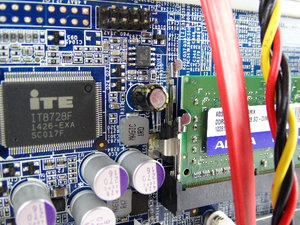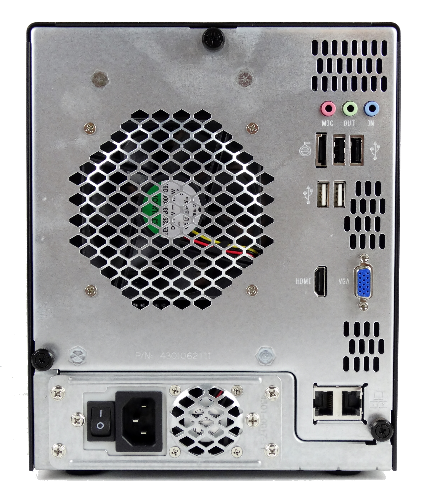Thecus W5000 WSS NAS Review
Low-cost Windows Storage Servers (WSS) give small businesses access to enterprise-class features at a desktop price.
Why you can trust Tom's Hardware
A Closer Look
The system should arrive with an outer box that contains the Thecus W5000 package (shown above) inside.


The packaging gives you useful information to help guide your purchasing decision in a retail environment. While we'd love to see even more detail conveyed on the box, Thecus' products are mainly available online. B&H does carry Thecus products in its retail stores, though.
Thecus includes an installation guide, Ethernet cable, power cable, screws for mounting drives and four drive sled keys.


Thecus has used this same chassis for several years on a number of models, including the current N5550 with its Linux OS. This is the company's go-to five-bay enclosure for lower-cost NAS products, but it does leave a little to be desired in the security department. The front door opens without a key lock. Anyone walking by can just press the middle-right edge, open the door and turn the system off. Though the drive sleds are lockable, we'd like to see a lock on that front door as well to keep unauthorized fingers out.


The front panel is straightforward and clutter-free. Power and reset buttons on the bottom are separated from the display control buttons. A single USB 3.0 port on the front of the system lets you charge a phone or back-up data from an external storage device. Status LEDs show power, network and disk activity.


Vents on the side of the chassis keep the internals cool through convection. The low-power Intel Atom processor is passively cooled, as is the chipset.
A large, 120mm fan blows air across the installed drives. Its size means the fan can spin slower than a smaller one to move the same amount of air. As a result, the configuration is extremely quiet, unlike some NAS systems that almost need to live in a closet.
Get Tom's Hardware's best news and in-depth reviews, straight to your inbox.


The HDMI and VGA outputs give you the option to plug in a monitor for configuration purposes. The four USB ports support keyboards and mice, so it's possible to use the system as a desktop. We wouldn't recommend it though, on account of the machine's 2GB of system RAM.
Seagate's speedy SSHD does help with performance somewhat. If you're not already familiar with SSHDs, they're essentially a marriage of traditional hard disks and tiny SSDs used for caching. Small SSDs are slow and hard drives are slow. When the two are paired, they are still fairly slow. But the benefit of an SSHD is that it utilizes specialized algorithms to keep commonly-used information in the NAND cache, improving performance beyond what a mechanical disk could achieve on its own.
Thecus' system offers two other notable I/O features. The first is eSATA. We normally don't care too much about whether that interface is present. Recently, however, I needed to add more storage to a NAS system that didn't have eSATA, and went mad after finding the system lacked eSATA support. Sometimes, features are not always used right away, but over time, they become indispensable.
Hopefully, that's also the case with the analog audio I/O on the back of Thecus' W5000. You get connections for a microphone, line in and audio out. But you'll have to fiddle with Windows Server 2012 R2 to get the audio functions working, since DirectX isn't enabled.
Thecus gives you access to a vacant memory slot for a performance upgrade. It also gives you the option to swap out the SSHD for an SSD if you'd like. Simply remove three thumbscrews on the back of the chassis to pop off the top cover.


Inside, there's an mSATA slot for solid-state storage. This option goes unused by default, but it's possible to convert the system over to a SATA 6Gb/s SSD, which could be useful for adding SSD cache to Windows Storage Spaces, if only Microsoft allowed SSD cache to work in RAID 5. Sadly, the feature only works with RAID 10 in Storage Spaces.
Current page: A Closer Look
Prev Page Pricing, Warranty And Accessories Next Page Software Interface
Chris Ramseyer was a senior contributing editor for Tom's Hardware. He tested and reviewed consumer storage.
-
Deuce65 "Low-cost Windows Storage Servers (WSS) give small businesses access to enterprise-class features at a desktop price."Reply
Um, is this a hardware review or a press release? -
Travis Hershberger While many people may actually use RAID 5 with this device, this is what we call professional malpractice among IT pros.Reply
Ref: http://www.smbitjournal.com/2012/11/one-big-raid-10-a-new-standard-in-server-storage
http://www.smbitjournal.com/2012/11/choosing-raid-for-hard-drives-in-2013
http://www.smbitjournal.com/2012/11/choosing-a-raid-level-by-drive-count
http://www.smbitjournal.com/2013/06/dreaded-array-confusion
http://www.zdnet.com/blog/storage/why-raid-6-stops-working-in-2019/805
http://www.zdnet.com/blog/storage/why-raid-5-stops-working-in-2009/162 -
CRamseyer You need to understand a couple of things about all of those articles. The articles are not talking about your home or small business NAS with four or five drives to start with. The ZDNET author has a history of writing articles and article titles to bring people in. Many disagree with Robin's findings. I wouldn't say that is the case with the only article that relates to this review though, Why RAID 5 Stops Working in 2009. In that article he references a 7-drive RAID 5 array. With 6 or more drives we use RAID 6 (RAID 10 in some cases) for the very reason he cites. With five drives and in a home or small business environment RAID 5 is sufficient as long as you are proactive. Keep the system on a battery backup, keep air vents fee of dust and if a drive fails replace it right away.Reply
Some users may want to take redundancy to the next level and run RAID 6 on a 5 drive array. That is fine and I know people that do. I don't recommend it on a sub-1000 Dollar system that already has performance issues with RAID 5 though. -
Marco Ullasci "We rarely hear of failures in the field"Reply
Here I am.
"In our own experience, NAS failures come from easy-to-replace fans and power supplies, rather than the main components that make up the heart of the system."
Changed power supply and changed fan but still no fun.
I had to dump my DS411Slim after putting some € on it in an attempt to fix.
The brown thing happens.



